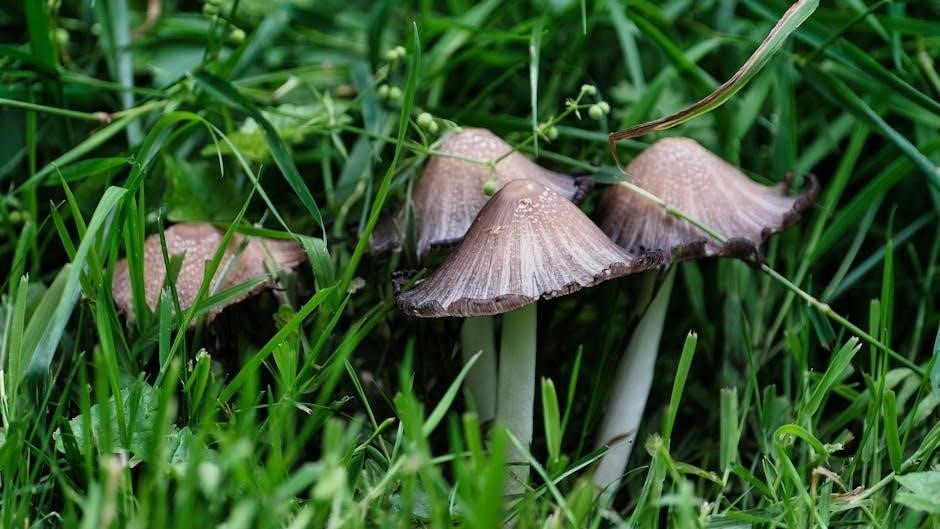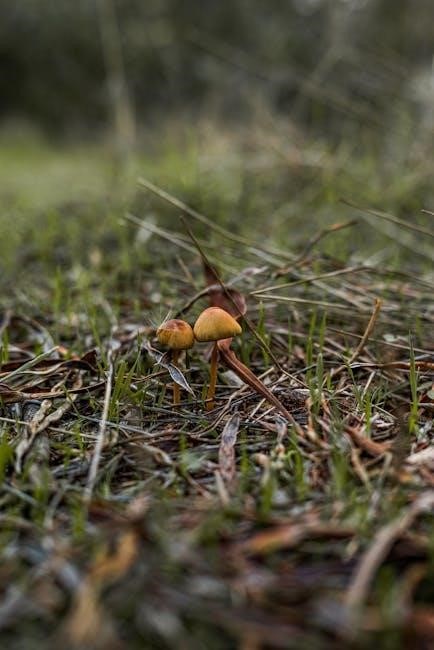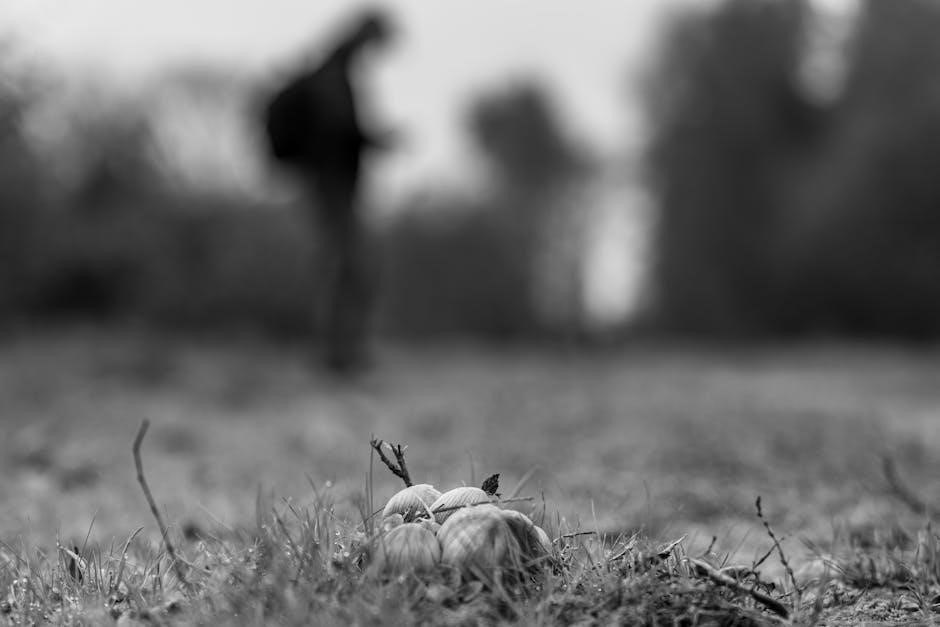peterson field guide to mushrooms

The Peterson Field Guide to Mushrooms is a comprehensive‚ portable manual for identifying over 1‚000 species across North America‚ featuring detailed descriptions and 700+ illustrations․
Overview of the Guide
The Peterson Field Guide to Mushrooms offers a detailed‚ user-friendly approach to identifying over 1‚000 species across North America․ With 700+ illustrations and concise descriptions‚ it focuses on key field observations‚ eliminating the need for microscopy․ Designed for portability‚ the guide is accessible to both amateurs and professionals‚ providing a comprehensive yet practical tool for mushroom enthusiasts․ Its organized structure and visual aids make it an indispensable resource for field identification and exploration․
Key Features and Approach
The guide emphasizes five key field features for mushroom identification‚ avoiding microscopic analysis․ It includes watercolor paintings and drawings that highlight subtle characteristics‚ comparative plates for easy differentiation‚ and detailed descriptions․ This approach ensures accuracy and accessibility‚ making it suitable for both beginners and experts․ The method focuses on observable traits‚ simplifying the identification process without compromising scientific rigor‚ thus fostering a deeper connection with the natural world through informed exploration․
Target Audience and Purpose
The Peterson Field Guide to Mushrooms is designed for amateur and professional mycologists‚ nature enthusiasts‚ and educators․ Its purpose is to simplify mushroom identification through detailed descriptions and visual aids‚ making it accessible to all skill levels․ The guide aims to foster scientific understanding and appreciation of fungi‚ encouraging exploration and informed foraging․ It serves as both a practical tool for fieldwork and a comprehensive reference for deeper study‚ catering to a wide audience interested in mycology․

Mushroom Identification Methods
The guide introduces a unique‚ observation-based approach‚ focusing on key features like shape‚ size‚ and habitat to simplify identification without requiring microscopic analysis․
Unique Identification Approach Based on Field Observations
The guide employs a groundbreaking method focused on five key field-observable features‚ such as shape‚ size‚ and habitat‚ eliminating the need for microscopic analysis․ This approach‚ designed for both amateurs and professionals‚ emphasizes visual and contextual details to streamline identification․ By prioritizing characteristics easily noticed in nature‚ the guide ensures accuracy and accessibility‚ making it an indispensable tool for mycologists of all skill levels․
Importance of Visual and Descriptive Details
The guide heavily relies on visual and descriptive details to aid in accurate mushroom identification․ Watercolor paintings and detailed drawings highlight subtle field marks‚ such as cap shape‚ gill arrangement‚ and stem characteristics‚ that are often overlooked․ Descriptive accounts of habitats‚ odors‚ and textures further enhance the identification process․ These elements‚ combined with a focus on observable features‚ make the guide an invaluable resource for both beginners and experienced mycologists‚ ensuring precise and confident species recognition in the field․
Differences from Other Mushroom Guides
The Peterson Field Guide to Mushrooms stands out for its unique‚ field-based approach‚ focusing on five key features observable without a microscope․ Unlike other guides‚ it emphasizes artistic watercolor illustrations over photographs‚ capturing subtle details that enhance identification․ Its portable design and clear organization make it more accessible to amateurs and professionals alike․ This guide’s combination of simplicity‚ accuracy‚ and visual appeal sets it apart as an essential tool for modern mycology enthusiasts․
Species Coverage and Details
The Peterson Field Guide to Mushrooms covers over 1‚000 species with detailed descriptions‚ providing in-depth information on each mushroom’s characteristics‚ habitat‚ and unique features for accurate identification․
Comprehensive List of Over 1‚000 Species
The Peterson Field Guide to Mushrooms catalogues over 1‚000 species‚ offering detailed descriptions‚ habitats‚ and distinguishing features․ This extensive coverage ensures enthusiasts and researchers alike can identify a wide range of fungi across North America․ Each entry is meticulously researched‚ providing insights into ecological roles and unique characteristics․ The guide’s breadth makes it an indispensable resource for both beginners and advanced mycologists seeking comprehensive knowledge of mushroom diversity․
Organization and Classification of Mushrooms
The Peterson Field Guide to Mushrooms is organized by morphological features and ecological habitats‚ making it user-friendly for field identification․ Mushrooms are grouped based on visible characteristics like cap shape‚ gill attachment‚ and growth patterns․ This logical classification system allows users to quickly narrow down species without requiring microscopic analysis․ The guide’s structure caters to both beginners and experts‚ ensuring efficient navigation through its extensive catalog of North American fungi․
Notable and Iconic Species Highlighted in the Guide
The guide showcases iconic species like the morel‚ chanterelle‚ and fly agaric‚ each highlighted with detailed descriptions and illustrations․ These species are chosen for their distinctive features and popularity among mushroom enthusiasts․ The guide also covers lesser-known but ecologically significant fungi‚ ensuring a balanced representation of North America’s diverse mycological landscape․ This approach helps users appreciate both common and rare species‚ making the guide invaluable for field exploration and study․

The Role of Illustrations and Visual Aids
The guide’s watercolor paintings and comparative plates provide vivid‚ detailed visuals‚ aiding in quick and accurate mushroom identification by highlighting subtle field marks and characteristics․
Watercolor Paintings and Drawings
The Peterson Field Guide features over 700 exquisite watercolor paintings and detailed drawings‚ capturing the intricate characteristics of each mushroom species․ These visuals‚ created by expert artists‚ emphasize subtle field marks that are often missed in photographs․ The illustrations are organized to facilitate easy comparison‚ allowing users to quickly identify species based on color‚ shape‚ and other distinguishing features․ This artistic approach enhances the guide’s practicality and aesthetic appeal for both amateur and professional mycologists․
Subtle Field Marks and Characteristics
The guide emphasizes subtle field marks‚ such as gill attachments‚ veil remnants‚ and cap textures‚ to aid in accurate identification․ These details‚ often overlooked‚ are crucial for distinguishing similar species․ The illustrations highlight these features‚ making them easier to recognize in the field․ This focus on observable characteristics ensures that users can identify mushrooms without relying on microscopic analysis‚ making the guide accessible to both novices and experienced mycologists․
Comparative Plates for Easy Identification
The guide features comparative plates that group similar species together‚ simplifying identification․ These plates highlight key differences in cap shape‚ gill color‚ and other features․ By visually comparing multiple species‚ users can quickly narrow down possibilities․ The detailed illustrations and descriptions emphasize distinguishing characteristics‚ making the process more efficient and accurate for both beginners and experienced mushroom enthusiasts․ This approach ensures that even subtle differences are apparent at a glance‚ enhancing the overall identification experience․

Author and Legacy
Roger Tory Peterson’s legacy shines in his field guide‚ offering a comprehensive‚ portable manual for mushroom identification․ It remains the ultimate resource for enthusiasts and experts alike․
Roger Tory Peterson’s Contribution to Mycology
Roger Tory Peterson revolutionized mushroom identification with his field guide‚ emphasizing observable features over microscopic analysis․ His innovative approach made mycology accessible to amateurs and professionals alike‚ blending detailed descriptions with stunning watercolor illustrations․ Peterson’s work not only simplified species recognition but also fostered a deeper appreciation for mushrooms in North America․ His legacy endures as a cornerstone of modern mycology‚ inspiring countless enthusiasts and scholars to explore the fungal world with precision and passion․
Impact of the Guide on Amateur and Professional Mycologists
The Peterson Field Guide to Mushrooms has profoundly influenced both amateur and professional mycologists‚ democratizing access to mushroom identification․ Its intuitive approach has empowered hobbyists to confidently explore the fungal world‚ while professionals appreciate its thoroughness and accuracy․ By bridging the gap between field observation and scientific precision‚ the guide has become an essential tool for education and research‚ inspiring a new generation of mycologists and fostering a deeper understanding of North America’s diverse mushroom species․
User Feedback and Reviews
The Peterson Field Guide to Mushrooms is highly praised for its portability‚ comprehensive approach‚ and stunning watercolor illustrations‚ making it a favorite among both amateurs and experts․
Popularity and reception Among Mushroom Enthusiasts
The Peterson Field Guide to Mushrooms is widely celebrated for its portability‚ detailed descriptions‚ and stunning watercolor illustrations‚ making it a beloved tool for mushroom enthusiasts․ Its user-friendly approach and focus on field-observable features have garnered praise from both amateur and professional mycologists․ The guide’s ability to simplify complex identification processes has made it a favorite among nature lovers and researchers alike‚ solidifying its reputation as an indispensable resource for mushroom exploration and study․

Testimonials from Experts and Beginners
Experts and beginners alike hail the Peterson Field Guide to Mushrooms as a groundbreaking resource․ Professionals praise its meticulous detail and innovative approach‚ while newcomers appreciate its accessibility․ One enthusiast noted‚ “The guide’s watercolor paintings and field-focused method make identification effortless;” Another user highlighted its portability‚ calling it “the ultimate companion for mushroom exploration․” Testimonials consistently highlight the guide’s ability to bridge the gap between amateur curiosity and professional mycology‚ fostering a deeper appreciation for fungi․
How to Use the Guide Effectively
Mastering the Peterson Field Guide involves observing key features like size‚ shape‚ and color․ Use the visual aids and descriptions to match your findings precisely in the field․
Best Practices for Field Identification
For accurate field identification‚ observe size‚ shape‚ and color‚ and note habitat and growth patterns․ Use the guide’s detailed descriptions and watercolor illustrations to match your findings․ Pay attention to subtle field marks‚ as they are crucial for distinguishing similar species․ Carry the guide in the field for quick reference‚ and cross-check visual and descriptive elements to ensure precise identification․ This approach‚ based on five key features‚ is designed to enhance your mushroom-hunting experience without requiring advanced tools like microscopes․
Utilizing Visual and Descriptive Elements
The guide’s watercolor paintings and detailed descriptions work together to highlight key characteristics‚ such as cap shape‚ gill arrangement‚ and stem features․ By focusing on visual cues like color variations and texture‚ users can quickly narrow down species․ Descriptive elements‚ including habitat notes and spore print information‚ further refine identification․ This combination of visual and textual detail ensures a comprehensive and accurate approach to mushroom identification‚ making it accessible to both novices and experienced enthusiasts․
Tips for Beginners
Beginners should start by examining the guide’s watercolor illustrations and detailed descriptions to understand key features․ Note the cap shape‚ stem color‚ and gill arrangement․ The guide’s simple approach focuses on observable characteristics‚ making it easy to identify species without advanced tools․ Carry the portable guide on field trips for quick reference․ For those interested in edibility‚ exercise caution and cross-reference findings with trusted sources to ensure safety․
The Peterson Field Guide to Mushrooms remains an indispensable tool for modern mycology‚ offering unmatched depth and accessibility․ Its legacy continues to inspire exploration and learning․
Value of the Peterson Field Guide in Modern Mycology
The Peterson Field Guide to Mushrooms is a cornerstone of modern mycology‚ bridging amateur and professional interests with its accessible yet detailed approach․ Its focus on field observations and visual details makes it invaluable for identifying species without laboratory equipment․ The guide’s comprehensive coverage of over 1‚000 species‚ supported by exquisite illustrations‚ ensures its relevance in both academic and recreational contexts․ It continues to inspire a deeper appreciation and understanding of fungi‚ fostering a connection between enthusiasts and the natural world․
Encouragement for Further Exploration
The Peterson Field Guide to Mushrooms invites readers to embrace the fascinating world of mycology‚ encouraging continued discovery and learning․ Its accessible format and detailed illustrations inspire enthusiasts to venture into the field‚ exploring diverse species and habitats․ By fostering a deeper connection with nature‚ the guide motivates readers to pursue further study‚ whether through scientific research or casual observation‚ ensuring a lifelong appreciation for the intricate beauty of fungi․



Leave a Reply
You must be logged in to post a comment.